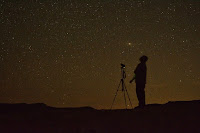We are already two weeks into 2021 and it's time for the first midmonth check-in of the year! I suspect that many of you have not been able to do much stargazing yet this year due to the cold and sporadic cloud cover over Utah. The only stargazing I've been able to do has been with my unaided eyes in the early evening after sunset or early morning before sunrise. I'm hoping to have a more serious stargazing outing, more specifically, an astrophotography outing, in the next month or so.
Due to the cold, some astronomers may turn to daytime viewing. This can involve viewing the Sun, with the appropriate solar filters and eye protection of course! Not only is now a good time, but this year will be a great time for viewing the Sun. If you don't already own a pair of solar glasses or a solar filter for your telescope, now would be a great time to buy one!
The Sun goes through cycles, which are known as solar cycles. A complete cycle lasts for approximately 11 years. During the cycle, the magnetic field of the Sun flips, meaning that the north and south poles completely change places. Through the complete cycle, the Sun will experience times of extreme activity, known as solar maximum or simply solar max, and also times of little to no activity, known as solar minimum or solar min. The activity of the Sun includes solar flares, solar wind, sunspots, and coronal mass ejections (CME).
Sunspots appear as black spots on the surface of the Sun. While sunspots are still quite hot, they are much cooler than the surrounding area, which make them appear black. Sunspots can appear in small or large groups, with large groups being large enough to see by simply wearing a pair of solar glasses. Below is a low quality animation taken in June of 2012 through my binoculars with solar filters during the transit of Venus. The planet appears as a large circle towards the right edge of the Sun. If you look closely, you should be able to see 4 large groups of sunspots.
Solar flares are the largest known explosive event in our solar system. These occur when the magnetic energy associated with a sunspot is released. Flares are studied primarily in the optical and x-ray range of the electromagnetic spectrum. When viewing in these spectrums, a flare will appear as a bright flash of light. Sunspots usually have large solar prominences connected to them. These prominences connect one sunspot to another. Sometimes, the prominences can extend for hundreds of thousands of miles above the surface of the Sun such as the image below taken by NASA in 2010.
This image has the Earth placed close to the Sun to compare the size of the Earth, the solar prominence, and the Sun. This really puts into perspective how tiny we are! Sometimes the solar prominences quietly die down back to the surface of the Sun. Occasionally, these prominences can "snap" ejecting massive amounts of energy known as a coronal mass ejection. A CME can contain millions to billions of tons of matter which can be accelerated to millions of miles per hour. A CME can be tied to solar flares, but can also occur by itself.
The solar wind is simply the outward motion of particles from the Sun. Since the Sun is a sphere, the solar wind radiates outwards in all directions equally and can reach everywhere in the solar system.
Solar wind and solar flares cannot directly harm humans on the surface of Earth due to the magnetic field surround the planet. However, astronauts outside of this protection, perhaps on the way to the Moon or Mars, can experience radiation poisoning. So far, CME's have not been known to directly cause harm to the inhabitants on Earth. They can disrupt satellites orbiting the planet, such as GPS, radio, and weather satellites. In extreme cases, a CME may knock out power, such as what happened in Quebec in 1989. The local residents were without power for only 9 hours.
Much of this activity causes particles to interact with particles in the atmosphere of the Earth. This can cause aurora which can be seen in high northern areas and low southern areas of the planet. During solar max, a solar flare or CME aimed at Earth, or a large amount of charged particles being carried by the solar wind can cause the aurora to extend to areas that typically do not experience them. Sometimes they can reach as far south as Utah!
Don't Forget....
On the 13th, we had a New Moon, meaning for those adventurous enough, now would be a great time to get outside to view the stars! Jupiter and Saturn are still moving closer to the Sun, leading up to their conjunctions on the 28th and 23rd, respectively. If weather has allowed you to view Mercury in the evening sky, you should have noticed this tiny planet climbing higher in the western sky. It will reach its highest point in the sky on the 23rd, being higher than Jupiter and Saturn, which should make it easy to spot!

















